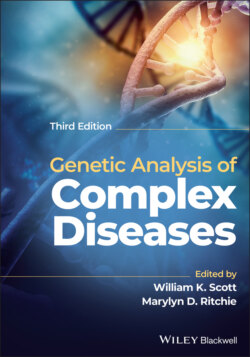Читать книгу Genetic Analysis of Complex Disease - Группа авторов - Страница 78
Heritability
ОглавлениеHeritability (h2) is a measurement of the genetic contribution to a trait, or how much of the trait variability can be attributed to genetics rather than other causes. Heritability may be defined in the broad or narrow sense. Heritability in the broad sense is defined as follows:
(3.4)
where V is the total phenotypic variance, G is the genetic variance of the phenotype, B is the within family variance of the phenotype, and E is the random environmental variance of the phenotype. The genetic variance can be further broken down into the additive (effects of alleles at a particular locus), dominance (effects of allelic interactions at a particular locus), and epistatic variance (effects of allelic interactions from multiple loci). Heritability in the narrow sense is a measure of the additive genetic variation in a trait. Estimates of heritability will vary between 0 and 1, with h2 = 0 representing traits that are entirely controlled by nongenetic factors and h2 = 1 representing traits that are entirely controlled by genetic factors. Here we will focus simpler methods of calculating heritability in the context of analyses defined in previous sections of the current chapter.
The correlation coefficient that one obtains from plotting a trait value in one relative versus the trait value in another relative may be used to calculate heritability in the narrow sense, provided that the relatives under consideration are not full siblings:
(3.5)
For example, if one plots the age of onset for a condition in a proband versus the age of onset in an affected parent, the square of the correlation coefficient (r2, or the slope of the line) obtained from the plot would be divided by 1/2, the number of alleles shared identical by descent (IBD) for a parent–child pair. This particular approach to calculating heritability does not represent heritability in the narrow sense when considering full siblings because one has to take into account dominance variance, as well. See Hartl and Clark (1997) for a more thorough discussion of using the covariance between two relatives to estimate heritability.
Rice and colleagues (1997) extended this approach to incorporate correlations from multiple relative pairs (rsib, siblings; rp‐o, parent–offspring; rsp, spousal):
(3.6)
